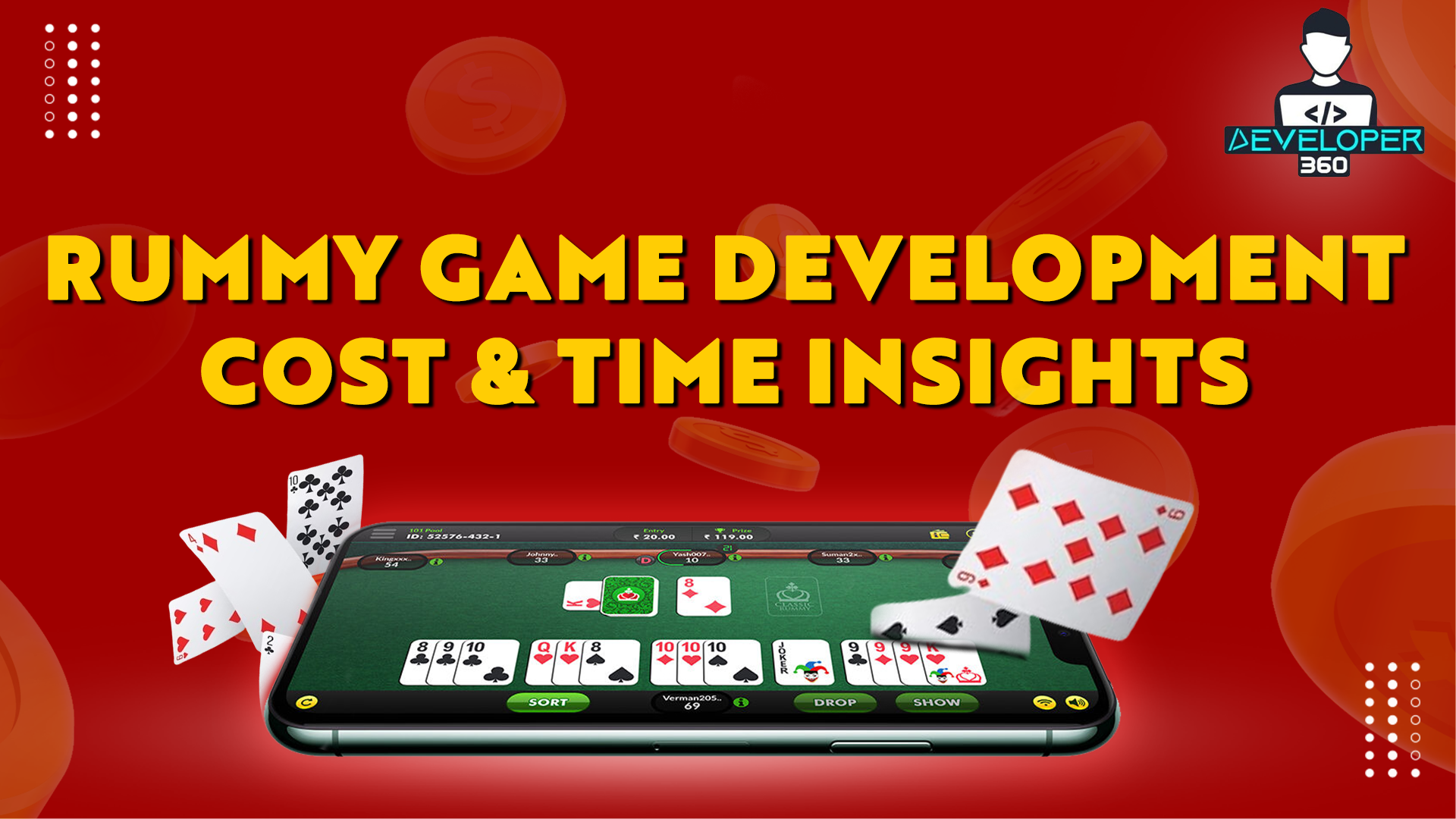Rummy Game Development: Cost & Time Insights
-
29 Apr, 2024
-
Developer 360- Best Game Development Company in Delhi

1. A Breakdown of Rummy Game Development Costs.
Development Team: This includes salaries for developers, designers, testers, and project managers. The number of team members and their salaries will depend on the complexity of the game and the development time.
Game Design: Designers will create wireframes, mockups, and the overall user interface (UI) and user experience (UX) design. This cost can vary depending on the complexity and quality of the design.
Programming: The cost of coding the game, including backend development, frontend development, and any integrations with third-party services like payment gateways or social media platforms.
Server Costs: If the game requires server infrastructure for multiplayer functionality or storing user data, there will be ongoing server costs for hosting and maintenance.
Art and Animation: Costs associated with creating artwork, animations, and visual effects for the game. This can include character design, card designs, backgrounds, and special effects.
Audio: Hiring composers, sound designers, and voice actors (if needed) to create music, sound effects, and voiceovers for the game.
Testing: Quality assurance (QA) testing to identify and fix bugs and ensure the game runs smoothly across different devices and platforms.
Marketing and Promotion: Budget for promoting the game through advertising, social media, influencer marketing, and other channels to attract players.
Licensing and Legal: Costs associated with obtaining necessary licenses for using certain technologies or intellectual property, as well as legal fees for drafting contracts and terms of service.
Updates and Maintenance: Ongoing costs for releasing updates, fixing bugs, and providing customer support after the game is launched.
Localization: If the game will be available in multiple languages, there will be costs associated with translating text and adapting content for different regions.
Contingency: It's wise to allocate some budget for unexpected expenses or changes in the project scope.
2.
Optimizing Development Time: Strategies for Efficient Rummy Game Development.
Define Clear Requirements: Start by outlining clear and concise requirements for the Rummy game. This includes game rules, features, UI/UX design, and any other specifications. Having a well-defined roadmap helps in avoiding ambiguity and reduces rework.
Use Pre-built Solutions: Leverage pre-built game engines, frameworks, and libraries to expedite development. Platforms like Unity, Unreal Engine, or HTML5 game development frameworks offer a wide range of tools and resources specifically tailored for game development.
Agile Development Methodology: Adopt an agile development approach with iterative cycles. Break down the development process into smaller tasks or sprints, allowing for continuous feedback, adjustments, and improvements. This fosters flexibility and adaptability throughout the development lifecycle.
Reusable Components: Develop reusable code components/modules that can be utilized across different parts of the game. This promotes code efficiency, reduces redundancy, and accelerates development by avoiding reinventing the wheel for common functionalities.
3. Comparative Analysis: Rummy Game Development Costs Across Platforms.
Mobile (iOS/Android):
Development Costs: Development costs for mobile platforms can vary greatly depending on factors such as the complexity of the game, graphics, features, and the experience of the development team. It can range from a few thousand dollars for a basic game to tens of thousands or even more for a high-quality, feature-rich Rummy game. Platform Fees: Both Apple App Store and Google Play Store charge a percentage of revenue earned through the app. This is typically around 30% but can vary based on sales volume and subscription model. Maintenance Costs: Ongoing maintenance costs include updates for compatibility with new OS versions, bug fixes, and feature enhancements. These costs can vary but are usually a fraction of the initial development cost.- Web: Development Costs: Developing a Rummy game for the web involves creating a web application that can be played in a browser. Costs can vary depending on the game's complexity and whether it's designed for desktop or mobile browsers. Typically, web development costs can be similar to mobile development costs. Hosting Costs: Hosting a web game involves ongoing fees for server space, bandwidth, and other resources. Costs can vary based on the amount of traffic the game receives and the resources required to run it smoothly.
- Desktop (Windows/Mac): Development Costs: Developing a Rummy game for desktop platforms involves creating standalone applications for Windows and/or Mac operating systems. Costs can be similar to mobile development costs, depending on the complexity of the game. Distribution Costs: Unlike mobile platforms, there are no direct distribution costs associated with desktop platforms. However, marketing and distribution efforts to promote the game may incur additional expenses.
- Cross-Platform Development: Development Costs: Developing a Rummy game that can be deployed across multiple platforms (e.g., mobile, web, desktop) using cross-platform development tools like Unity or Unreal Engine can streamline development efforts and reduce costs compared to developing separate versions for each platform. Licensing Costs: Some cross-platform development tools may require licensing fees, which can add to the overall development cost but may still be more cost-effective than developing separate versions for each platform.
4. The ROI Perspective: Evaluating the Return on Investment in Rummy Game Development:
Market Analysis: Conduct thorough market research to understand the demand for rummy games. Analyze the target audience, competitors, and trends in the gaming industry.
Development Costs: Calculate the expenses involved in developing the rummy game, including software development, design, testing, and marketing. Consider whether you'll develop the game in-house or outsource it to a game development company.
Monetization Strategy: Determine how you'll generate revenue from the game. Common monetization strategies for rummy games include in-app purchases, advertisements, and subscription models.
User Acquisition Costs: Estimate the expenses associated with acquiring users for the game. This may include advertising costs, influencer partnerships, and user acquisition campaigns.
Retention and Engagement: Assess the potential for player retention and engagement. A successful rummy game should have features that keep players coming back, such as tournaments, rewards, and social interaction.

